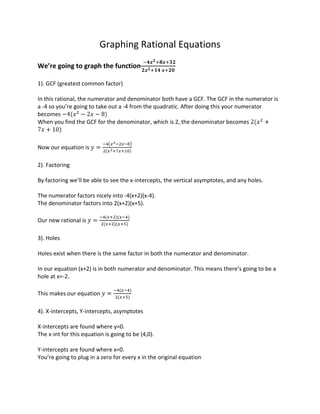
DEV
- 1. Graphing Rational Equations We’re going to graph the function 1). GCF (greatest common factor) In this rational, the numerator and denominator both have a GCF. The GCF in the numerator is a -4 so you’re going to take out a -4 from the quadratic. After doing this your numerator becomes When you find the GCF for the denominator, which is 2, the denominator becomes Now our equation is 2). Factoring By factoring we’ll be able to see the x-intercepts, the vertical asymptotes, and any holes. The numerator factors nicely into -4(x+2)(x-4). The denominator factors into 2(x+2)(x+5). Our new rational is 3). Holes Holes exist when there is the same factor in both the numerator and denominator. In our equation (x+2) is in both numerator and denominator. This means there’s going to be a hole at x=-2. This makes our equation 4). X-intercepts, Y-intercepts, asymptotes X-intercepts are found where y=0. The x-int for this equation is going to be (4,0). Y-intercepts are found where x=0. You’re going to plug in a zero for every x in the original equation
- 2. = 1.6 y-int is (0,1.6) Vertical asymptotes are found where denominator equals zero. X=-5 Horizontal asymptotes are found by dividing the coefficients ( -4/2) y=-2 We have all the information needed to graph now! Hole: x=-2 X-intercept: (4,0) Y-intercept: (0,1.6) Vertical Asymptote: x=-5 Horizontal Asymptote: y=-2 This is what the graph will look like
- 3. Now the function we’re going to graph is We’re going to follow the same steps as the last equation, but since there’s no GCF, we’re going to skip right to factoring. Since there are no holes, this means there will be two vertical asymptotes and two x-intercepts. X-intercepts: (-3,0) and (4,0) Y-intercepts: (0,2) Horizontal Asymptote: y=1 Vertical Asymptote: x= -2 and 3 Because there will be two vertical asymptotes, we will need to make a sign chart. This shows which direction the graph will approach the asymptotes. You’re going to pick a number close to the asymptote and plug it into x. For -2, plug in -1.9 and for 3, plug in 2.9 x-> -2 from the right 3 from the left X=-1.9 X=2.9 y-> + + The graph will look like this:
- 4. Farmer Ted! Farmer Ted has 2000 feet of fencing to enclose his new rectangular pasture on a river. We need to find the largest amount of field that can be enclosed with this much fencing. Perimeter Area Set the total perimeter equal to the perimeter equation then solve for y.
- 5. 2000=2x+2y (subtract 2x from both sides) -2x -2x 2000-2x=2y (divide both sides by two) 1000-x=y Now plug 1000-x for the “y” value in the area equation Area= x(1000-x) or To find the x-value, use the equation Now plug 500 in for x in the area equation. Area= = 250000 The largest area possible this field is 250000 Graphing Polynomials At x=4, the graph will bounce because it’s an even degree At x=-3 the graph will go straight through because there isn’t a degree At x=-5 the graph will curve through Also, the graph is a positive graph to the 6th degree so it will look like this
- 6. Negative graph and odd degree X=-3 bounce X=3 curve through X=6 bounce
- 7. For our first two problems, we chose to do graphing rationals. This was something both Taylor and I struggled with throughout the course of this class. We chose these two problems because by explaining how to do them, we taught ourselves about them more. Especially with the sign chart, we needed to review on how to graph each problem. For our third problem, we chose to do a ‘Farmer Ted’ problem. We chose this because it was a concept that we both enjoyed. It was something that made sense to both of us and we were able to explain it easier than the other problems. For our fourth and fifth problems, we did graphing polynomials. This was another concept we both enjoyed and understood very well. It was easier to explain because we knew what to do. With this project, I found out that if you know more about a concept, it’s easier and more enjoyable to teach someone else. With the rationals, that wasn’t my favorite thing, so I didn’t enjoy explaining it. But on the other hand, I loved Farmer Ted problems and that was both easier and more enjoyable to do. Dannica
- 8. Throughout this trimester Danni and I have learned a lot about Pre-calc Functions. By completing this assignment To Develop your Expert Voice it really showed us how much we actually did know. We chose the problems we did because those were the problems we had the most problems within the pervious units. The problems we created were two graphing rationales, a farmer ted problem, two graphing polynomials, and lastly a rational over rational. Furthermore, by explaining our problems in great detail it shows that we understand what we are talking about. This assignment was very educational. By Mr. Jackson giving us this project right at the end of the trimester, it was a great review of our knowledge for the exam. There were some problems I was unsure about how to do them but being able to work in partners and putting Danni and I together we figured it out. Danni and I put our strengths and weaknesses together to complete this project. I do not know about Danni, but I know that I thought this project was very beneficial for me.